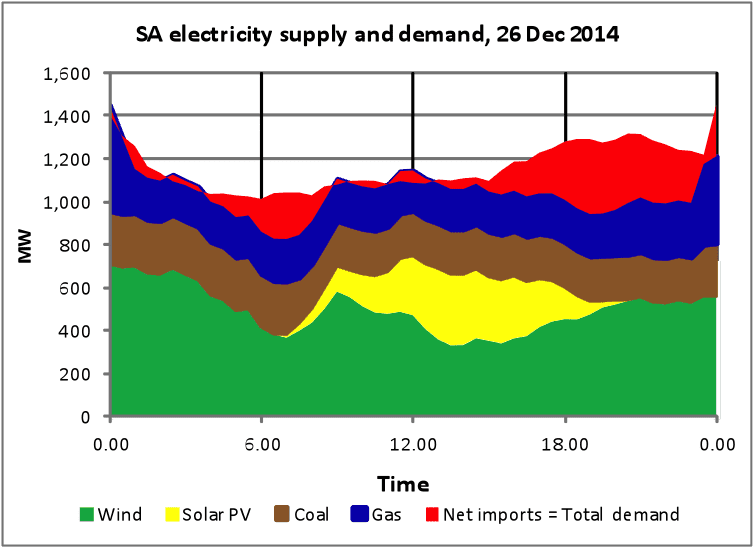We’ve documented the growing impact of rooftop solar on the electricity market in South Australia on many occasions, but on Boxing Day just passed it may have hit a new record.
According to this graph from the Australian Photovoltaic Institute’s Solar Map, rooftop solar contributed up to one third of total demand in the state in the middle of the day, and at least 30 per cent from 11.30am to 3.30pm.
The South Australian grid operator has recognised the benefits of rooftop solar on the grid – it says it has pushed the peak back much later in the day, reduced the breadth of peak demand (much to the chagrin of the conventional generators who relied on the peaks for income), and reduced stress on the grid at peak times.
Indeed, this graph here shows over the three days around Boxing Day. It registers only grid demand, so not rooftop solar. Notice the dips during the day – from the grid’s point of view, off-peak now comes in the middle of the day.
But here is what the total electricity demand looks like with solar included – courtesy of the APVI Solar Map data and some chart-work from energy analyst Hugh Saddler at Pitt&Sherry.
It shows that wind accounted for nearly half of total demand on December 26. Which means that wind and solar accounted for around two thirds of total demand for large parts of the daytime hours, and just over half over the 24-hour period.
Saddler notes that total electricity demand in SA on December 26 was low for summer because the day was relatively cool (maximum temperature in Adelaide 23.4 deg. C) and also a public holiday.
“That said, the data show that there is no technical impediment to renewable sources of generation supplying a high proportion of total electricity requirements,” Saddler says.
” The combined share of wind and solar for the whole day (midnight to midnight) was 52 per cent. The data also show the benefits of technology diversity in renewable generation. Wind and solar generation complement each other when, as is very often the case in SA, there is more wind overnight than during the day.
“This demonstrates that, when Australia eventually gets serious about transforming its electricity industry towards a low emission future, both technologies should be important parts of the total generation mix.”
And, Saddler adds, the data shows the economic benefits for electricity consumers of interconnections between states. For most of the day low cost brown coal electricity imported from Victoria displaced higher cost local coal and gas generation in SA, but on a couple of occasions surplus generation from wind in SA flowed east, helping to keep prices in Victoria slightly lower than they would otherwise have been.
There are several things to note about South Australia. It has the highest penetration of rooftop solar in the country, with more than 23 per cent of all customers having solar. It also has nearly 50 per cent of all wind capacity in the country, at around 1,500MW.
And as a result of all that, one of its two major coal generators is mothballed, and the other operators only part of the time. And its biggest gas plant, the Torrens facility owned by AGL Energy, will close half its capacity too because it is no longer needed.
Indeed, on an annualised basis, the state now meets around 40 per cent of total demand through wind and solar. That is expected to jump significantly in coming years.
The state government has a 50 per cent target by 2025, but in reality it could go much higher than that – even to 100 per cent – particularly if the national renewable energy target remains in place.
The prevalence of variable wind and solar underlines the importance of energy storage going forward. But battery storage is already proving to be economic, particularly in the role of avoiding costly upgrades and extensions to the network of poles and wires.
This in turn will encourage more renewables. The SA grid operator itself suggests that the future may lie in a series of renewables based micro grids based – it sees little future for conventional generators, or even conventional electricity retailers.













